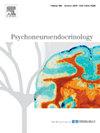Elevated serum angiotensin ii levels in children and adolescents with anxiety disorders
IF 3.4
2区 医学
Q2 ENDOCRINOLOGY & METABOLISM
引用次数: 0
Abstract
Purpose
Angiotensin II peptide is implicated in oxidative stress, neuropathology, and the serotonergic system. We investigated the serum angiotensin II levels in non-medicated children and adolescents with anxiety disorders.
Materials and Methods
Thirty-nine children and adolescents diagnosed with anxiety disorders and thirty-five controls participated in this study to investigate the potential association between anxiety disorders and serum angiotensin II levels. Parents of the participants completed the RCADS-P parent version to assess their children’s anxiety and depression levels.
Results
Higher serum angiotensin II levels were found in individuals with anxiety disorders compared to the control group. We found that social phobia, panic disorder, low mood (major depressive disorder), and generalized anxiety disorder subscale scores on the RCADS-P were significantly correlated with angiotensin II levels.
Conclusions
We found that children and adolescents with anxiety disorders had higher serum angiotensin II levels. The current findings align with previous research on the role of angiotensin II in other mental health conditions. Further research is necessary to elucidate its role in anxiety disorders.
儿童和青少年焦虑症患者血清血管紧张素ii水平升高
目的:血管紧张素II肽与氧化应激、神经病理和血清素能系统有关。我们调查了未服药的儿童和青少年焦虑症患者血清血管紧张素II水平。材料和方法:39名诊断为焦虑症的儿童和青少年和35名对照组参与了本研究,以调查焦虑症与血清血管紧张素II水平之间的潜在关联。参与者的父母完成了RCADS-P父母版本来评估他们孩子的焦虑和抑郁水平。结果:与对照组相比,焦虑障碍患者血清血管紧张素II水平较高。我们发现社交恐惧症、惊恐障碍、情绪低落(重度抑郁症)和广泛性焦虑障碍的RCADS-P亚量表得分与血管紧张素II水平显著相关。结论:我们发现患有焦虑症的儿童和青少年血清血管紧张素II水平较高。目前的发现与先前关于血管紧张素II在其他精神健康状况中的作用的研究一致。需要进一步的研究来阐明其在焦虑症中的作用。
本文章由计算机程序翻译,如有差异,请以英文原文为准。
求助全文
约1分钟内获得全文
求助全文
来源期刊

Psychoneuroendocrinology
医学-精神病学
CiteScore
7.40
自引率
8.10%
发文量
268
审稿时长
66 days
期刊介绍:
Psychoneuroendocrinology publishes papers dealing with the interrelated disciplines of psychology, neurobiology, endocrinology, immunology, neurology, and psychiatry, with an emphasis on multidisciplinary studies aiming at integrating these disciplines in terms of either basic research or clinical implications. One of the main goals is to understand how a variety of psychobiological factors interact in the expression of the stress response as it relates to the development and/or maintenance of neuropsychiatric illnesses.
 求助内容:
求助内容: 应助结果提醒方式:
应助结果提醒方式:


